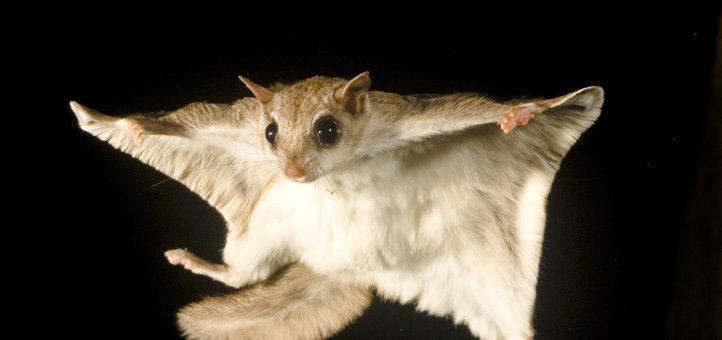
Southern flying squirrel. Photo courtesy Phil Myers/University of Michigan Museum of Zoology
Maryland is home to a variety of squirrel species. The gray squirrel is seemingly everywhere, especially in urban and suburban locations. The red squirrel is found mostly in the western part of the state, preferring evergreen trees. The Delmarva fox squirrel is found only on the Eastern Shore, and was removed from the Endangered Species list in December 2015.
But the one species that most have not seen is the Southern flying squirrel. The main reason is that this mammal is nocturnal and lives high in the trees of hardwood forests across the state. You may hear them before you see them; their calls are most often heard within the first few hours after sunset. Their series of high-pitched, excited-sounding cheeps are used to keep track of their fellow squirrels and to issue warnings. Some of these vocalizations are higher in frequency that humans can hear.
Southern Flying Squirrel Vital Statistics

Southern flying squirrel gliding. Photo courtesy of www.crittercontroltriangle.com
Appearance: Soft, greyish-brown fur with white belly. Large eyes with dark rings around them. Prominent ears and whiskers.
Size: 2.5 ounces average weight; 8-12 inches average length
Lifespan: 5 to 6 years old in the wild
|
Autumn nights are the best time to observe these squirrels, because they are particularly active as they gather food for the winter. As omnivores, they have a varied diet. It includes nuts and acorns, seeds berries, fruits, leaf buds, fungi, and bark. (One sure sign that your woodland has southern flying squirrels is the presence of gnawed hickory nuts at the base of large hickory trees.) Additionally, they will consume bird eggs, insects, and carrion. They are beneficial to woodlands through their dispersal of acorns and nuts, and by their dispersal of certain fungi that are beneficial to tree root systems.
Fall is also the end of the southern flying squirrel’s second young-rearing season. They mate in February and March, and then again during June and July. However, little is known about the species’ courtship and mating practices. After a period of gestation lasting forty days, the female gives birth to an average litter of two to three young. The young nurse for two months and are independent after four months. These are unusually long periods for animals this size; one theory is that the extended time spent with adults helps them master their “flying.”
Of course, flying squirrels do not actually fly. They have a special flap of loose skin between the wrists and ankles stretches out to resemble a parachute. Their wide and flat tail is used for guidance. These adaptations not only allow them to glide from upper to lower branches with ease, but also enable them to glide up to 250 feet and make 90-degree turns in midair. Their large eyes enhance night vision, enabling them to navigate between trees in the dark.
The southern flying squirrel is a highly social mammal. They are often observed in large groups, gliding and foraging together.
The “safety in numbers” strategy protects them against a variety of predators. They are often hunted during their glides by hawks and owls, and by other species that can climb well, such as weasels, raccoons, bobcats and house cats. It also helps them survive the winter months. Because they do not hibernate, groups of 15-20 squirrels will often nest communally in a tree cavity, an abandoned woodpecker hole, or a vacant nest box. They gather nesting materials such as dry leaves, shredded bark, moss, fur and feathers to line the floor of the cavity, and will spend the winter together to share body warmth.
For more information about the Southern flying squirrel:
Maryland Mammals: Southern Flying Squirrel (Maryland Department of Natural Resources)